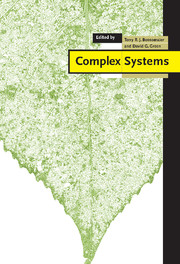Book contents
- Frontmatter
- Contents
- 1 Introduction
- 2 Self-organisation in complex systems
- 3 Network evolution and the emergence of structure
- 4 Artificial life: growing complex systems
- 5 Deterministic and random fractals
- 6 Non-linear dynamics
- 7 Non-linear control systems
- 8 Parallel computers and complex systems
- 9 Are ecosystems complex systems?
- 10 Complexity and neural networks
- Index
8 - Parallel computers and complex systems
Published online by Cambridge University Press: 04 August 2010
- Frontmatter
- Contents
- 1 Introduction
- 2 Self-organisation in complex systems
- 3 Network evolution and the emergence of structure
- 4 Artificial life: growing complex systems
- 5 Deterministic and random fractals
- 6 Non-linear dynamics
- 7 Non-linear control systems
- 8 Parallel computers and complex systems
- 9 Are ecosystems complex systems?
- 10 Complexity and neural networks
- Index
Summary
Introduction
The power of high performance computingl is being used in an increasingly wide variety of applications in the physical sciences, and in particular in the study of complex systems. The performance of supercomputers has increased by roughly a factor of two every 18 months since electronic computers were first developed. A number of supercomputer manufacturersaare aiming to deliver Teraflop (1012 floating point operations per second) performance well before the end of the decade.
Hardware trends imply that all computers, from PCs to supercomputers, will use some kind of parallel architecture by the end of the century. Until recently parallel computers were only marketed by small start-up companies (apart from Intel Supercomputer Systems Division), however recently Cray, Hewlett-Packard and Convex, IBM, and Digital have all begun marketing commercial parallel computers. Software for these systems is a major challenge, and could prevent or delay this hardware trend toward parallelism. Reliable and efficient systems software, high level standardised parallel languages and compilers, parallel algorithms, and applications software all need to be available for the promise of parallel computing to be fully realised.
A characteristic feature of the research on parallel computing at the Caltech Concurrent Computation Program (C3P), and more recently the Northeast Parallel Architectures Center (NPAC) at Syracuse University, is that many of the people who have worked in these groups (including ourselves) have a background in physics, so much of this research has made use of ideas from both physics and computer science. The goal of this work has been to make parallel computers more effective and easier to use for a wider variety of applications (Fox, 1987, 1988b, 1992a, Fox et al., 1988b, Angus et al., 1990).
- Type
- Chapter
- Information
- Complex Systems , pp. 289 - 338Publisher: Cambridge University PressPrint publication year: 2000
- 2
- Cited by

